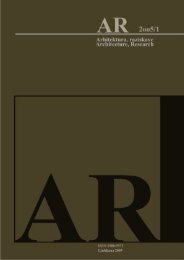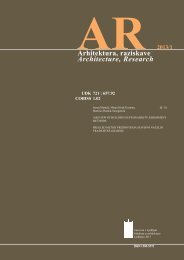VeÄ - Fakulteta za arhitekturo - Univerza v Ljubljani
VeÄ - Fakulteta za arhitekturo - Univerza v Ljubljani
VeÄ - Fakulteta za arhitekturo - Univerza v Ljubljani
Create successful ePaper yourself
Turn your PDF publications into a flip-book with our unique Google optimized e-Paper software.
THE DEANS FOREWORD<br />
The Faculty of architecture in Ljubljana is generally considered one of the best Central European schools of architecture.<br />
Confirmation of its quality comes from numerous successful students and graduates, often achieving enviable results domestically<br />
and abroad, as well as its high quality teaching staff effectively covering most contemporary issues of architectural creativity.<br />
There are almost 700 students enrolled in the graduate course while the teaching and associate staff includes some 50<br />
employees. Enrolment in the Faculty entails an entrance exam. Each year 120 regular and 45 part-time students are accepted.<br />
In the year 2000 the 3000th student graduated from the Faculty. Our graduates are known for their general and professionally<br />
profiled knowledge and systematic project approach enabling successful employment in various fields of artistic and architectural<br />
endeavours – from graphic design, scenography, interior design, architectural and urban design to physical planning.<br />
uvod introduction<br />
The Faculty has vital and rich ties to the best Central European cultural tradition. The foundations for organised architectural<br />
education in Ljubljana reach to the year 1919, when the Austro-Hungarian monarchy collapsed and the University in Ljubljana<br />
was established, or rather the year 1920, when the first department for architecture was established under the leadership of<br />
Ivan Vurnik. Vurnik was an ardent supporter of technical understanding of the discipline, aligned to the Parisian Les Beaux Arts.<br />
Thus the entry of Jože Pleènik, with the studio approach and artistic tradition of Otto Wagners’ school was extremely important<br />
for the later balance in programme and ideas. The stated duality between technical and artistic aspects of the discipline has<br />
since been a constant feature of the faculties study course.<br />
After Vurnik and Pleènik had so significantly marked the period between the two wars, they were appropriately replaced by a<br />
younger generation of architects, led by Edo Mihevc and Edo Ravnikar, both arguing for modern architectural approaches. In<br />
the post-war period the Department of architecture was for many years part of the Faculty of architecture, civil engineering and<br />
geodesy, except for a short period between 1950-1954 when it was independent within the framework of the Technical<br />
faculties. Similar to Vurnik and Pleènik, even Mihevc and Ravnikar were active in varied fields of professional involvement and<br />
significantly contributed to the countries reconstruction and development. Their pedagogical work was closely tied to large scale<br />
practical projects in which they also involved their students.<br />
In 1995 the Department of architecture, until then part of the Faculty of architecture, civil engineering and geodesy, transformed<br />
into an independent Faculty of architecture. We have however maintained tight academic ties to the former joint faculty and<br />
nourish the tradition of intertwining education with practice. For this purpose we have successfully co-opted several leading<br />
professionals from Slovenian practice to the teaching staff, that can translate their rich practical and theoretical experiences to<br />
the younger generation. The basis for qualifying of teachers to the Faculty is artistic and scientific merit. Alongside the numerous<br />
successful artists from the teaching staff we also employ many professors oriented towards theoretical subjects, who have<br />
gained their prowess at foreign universities. Every year two visiting professors from abroad join the fifty employed professors<br />
and teaching staff.<br />
The first master ateliers of prof. Vurnik and prof. Pleènik confronted the problem of teaching space. The temporary Technical<br />
4 <strong>Fakulteta</strong> <strong>za</strong> <strong>arhitekturo</strong>, Ljubljana Faculty of Architecture, Ljubljana

















